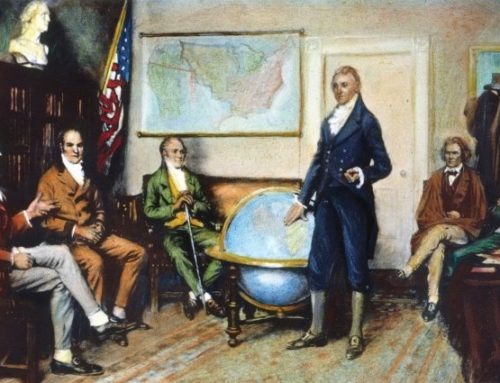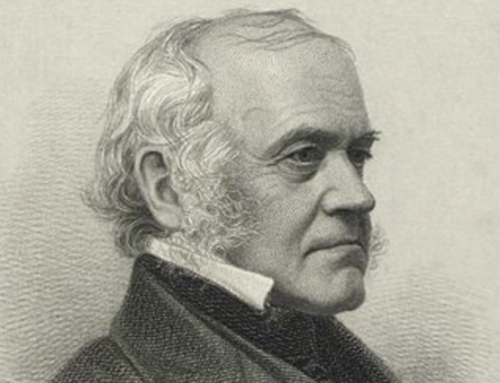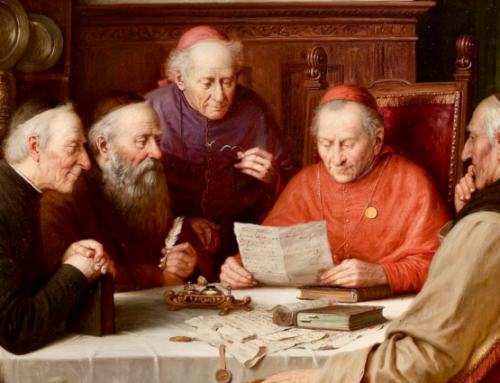In his short story, “Leaf by Niggle,” J.R.R. Tolkien provides a much more colourful and comforting purgatorial vision than that afforded by Dante. Niggle, a personification of the Artist, recognizes the landscape as the perfect, living form of which his painting was but a shadow or a foreshadowing.
 J.R.R. Tolkien expressed a dislike for formal or crude allegory, spurning the employment of personified abstractions in his work. You will search in vain in Middle-earth for any giants called Despair or any beautiful women by the name of Lady Philosophy. You will find no knight in shining armour named Sir Reason doing battle with a monster named the Spirit of the Age, nor will you find Sir Reason’s noble handmaid, Lady Theology. And yet Tolkien did indulge himself with this form of allegory in a short story called “Leaf by Niggle” in which he philosophizes on the meaning of life, and the purpose of art, taking the reader with him on a journey through the dark tunnel of death to the mysterious realm of purgatory.
J.R.R. Tolkien expressed a dislike for formal or crude allegory, spurning the employment of personified abstractions in his work. You will search in vain in Middle-earth for any giants called Despair or any beautiful women by the name of Lady Philosophy. You will find no knight in shining armour named Sir Reason doing battle with a monster named the Spirit of the Age, nor will you find Sir Reason’s noble handmaid, Lady Theology. And yet Tolkien did indulge himself with this form of allegory in a short story called “Leaf by Niggle” in which he philosophizes on the meaning of life, and the purpose of art, taking the reader with him on a journey through the dark tunnel of death to the mysterious realm of purgatory.
The protagonist of the story is a man called Niggle, a word which means “irritate.” Niggle is characterized by his irritability, especially towards his neighbor, the aptly named Mr. Parish, who is always keeping him from finishing the huge landscape painting on which Niggle is working and which he needs to complete before being forced to go on an unavoidable journey.
Niggle can be seen as a personification of the Artist, in general, but also as a personification of Tolkien himself, insofar as the story can be seen as autobiographically significant. Tolkien, like Niggle, was passionate about finishing his own literary landscape, the legendarium of unfinished tales which would be published posthumously as The History of Middle-earth, and, like Niggle, he was always being pulled away from his work by the demands of his family, friends, and neighbours.
Due to Mr. Parish’s incessant demands on his time, Niggle’s progress on the painting is painstakingly slow. “At any rate,” he says to himself, “I shall get this one picture done, my real picture, before I have to go on that wretched journey.” In the event, he has to go on the journey sooner than he realized. A tall man, dressed in black, calls on him unexpectedly. “Come along!” the man says. “I am the Driver…. You start today on your journey.”
Niggle begins to weep, exclaiming that his painting is not finished.
“Not finished?” says the Driver. “Well, it’s finished with, as far as you’re concerned, at any rate. Come along!”
The Driver gives Niggle no time to pack, telling him that he ought to have done that already. Catching the train, Niggle falls asleep just as the train enters a dark tunnel.
The meaning of the allegory is simple and straightforward enough. The journey is that on which all of us must embark, which will take us from this life to whatever comes after it. Although it is inevitable and long expected, we know not the day nor the hour on which we must make it. The Driver is Death himself, the Grim Reaper, and the dark tunnel is the moment of death, or the passage from this world to the next.
Niggle wakes up in a railway station.
“Ah, there you are!” says the Porter, who was clearly expecting him. “This way! What! No luggage? You will have to go to the Workhouse.” Being unprepared at the moment of death, having failed to keep watch as St. Matthew admonishes, Niggle is clearly unfit for heaven. He is taken by ambulance to the Workhouse Infirmary. “It was more like being in a prison than in a hospital,” the narrator informs us.
Niggle has to work hard, doing the kind of chores which had always niggled him because they had kept him from his painting. He does a lot of digging, which he had failed to do in his earthly life, neglecting his garden, much to Mr. Parish’s annoyance, and he was only permitted to paint bare boards in one plain colour. He spends a lot of time alone, so that he can “do some thinking.” As time passes, he begins to see things differently. He is less niggled by Mr. Parish, when he thinks of him, and regrets not having helped him more when he had the opportunity. There is no sense of rush. He is “quieter inside” and has an inner-peace which had always eluded him in the past.
Lying in the dark, Niggle hears two voices, one of which is “severe” and the other “gentle.” The latter is “a voice of authority” which sounds both hopeful and sad. As we listen to the voices discussing “Niggle’s case,” we realize that they are the voices of Justice and Mercy. After due deliberation, the Second Voice declares that it is time for Niggle to progress to more gentle treatment. The First Voice agrees, saying that Niggle should continue to the next stage of his recovery. Niggle catches the train once again and is taken to a station in the middle of a beautiful landscape. As the train departs, he sees a bicycle with his name written on it. As he rides the bicycle through the countryside, he begins to experience a feeling of déjà vu. He seems to have seen or dreamed of the sweep of grass over which he is riding. The curves of the land seem somehow familiar. “Yes: the ground was becoming level, as it should, and now, of course, it was beginning to rise again. A great green shadow came between him and the sun. Niggle looked up, and fell off his bicycle…. Before him stood the Tree, his Tree, finished. If you could say that of a Tree that was alive, its leaves, its branches growing and bending in the wind.” It was exactly what Niggle had felt or guessed but had so often failed to catch when he had his brush in hand. All the leaves he had ever labored at are there, “as he had imagined them rather than he had made them.” There are also other leaves “that had only budded in his mind, and many that might have budded, if only he had had time.”
Gazing at the Tree, he lifts his arms slowly and opens them wide in an expression of praise.
“It’s a gift!” he exclaims.
Surveying the broad sweep of the landscape surrounding the tree, he recognizes this also as his painting, only in its perfect, living form, of which his own painting was but a shadow or a foreshadowing. The forest, his forest, opened in all directions and marched off into the distance. Beyond were the mountains, glimmering on the distant horizon. The mountains do not seem to belong to the picture, except as something connected it so something else, a glimpse of something further and deeper than anything he had ever seen or imagined.
Niggle is eventually joined by Mr. Parish who had evidently also taken the journey through the dark tunnel:
As they worked together, it became plain that Niggle was now the better of the two at ordering his time and getting things done. Oddly enough, it was Niggle who became most absorbed in building and gardening, while Parish often wondered about looking at trees, and especially at the Tree.
They are joined by a man who looked like a shepherd. He had arrived from higher up in the mountains and offered to be their guide if they were ready to explore further up and further in, beyond the “edge” of anything they had ever imagined. The shepherd explains to Mr. Parish that he had been too blind in his mortal life to see the beauty of Niggle’s painting.
“But it did not look like this then,” said Parish, “not real.”
“No,” the shepherd replies, “it was only a glimpse then, but you might have caught the glimpse, if you had ever thought it worth while to try.”
Niggle takes his leave of Mr. Parish, who is going to linger until his wife joins him, and accompanies the shepherd on a journey into the mountains. As with the image of the mountains in C.S. Lewis’s Great Divorce and The Last Battle, they represent a much more colourful and comforting purgatorial vision than that afforded by Dante. And so we will leave Niggle, who no longer lives up to his name, wandering further up and further in:
He was going to learn about sheep, and the high pasturages, and look at a wider sky, and walk ever further and further towards the Mountains, always uphill. Beyond that I cannot guess what became of him. Even little Niggle in his old home could glimpse the Mountains far away, and they got into the borders of his picture; but what they are really like, and what lies beyond them only those can say who have climbed them.
The Imaginative Conservative applies the principle of appreciation to the discussion of culture and politics—we approach dialogue with magnanimity rather than with mere civility. Will you help us remain a refreshing oasis in the increasingly contentious arena of modern discourse? Please consider donating now.
The featured image is courtesy of Pixabay and has been brightened slightly.







Thank you! Tolkien is a true master and, your article is masterfully done!
God bless
Thanks Joseph for your article. I had not read this piece in many years. At 59, I’m much closer to Niggle’s Parish than when I first read it. It was a wonderful, emotional read for me.
I so appreciate The Imaginative Conservative—it’s a wonderful resource.
Thank you for the piece, but I think you have hold of the wrong definition of “niggle.” IMO the correct one is the first one in the OED: “To do something in a painstaking, finicky, fussy, or ineffective manner; to trifle, fiddle; to waste effort or time on petty details.” Tolkien said in Letters 236 that “I am a natural niggler, alas!”
Mr Handley, I am very grateful for your fraternal correction. I was using the word “niggle” in the way in which it was used back in my native England in my own experience. The other definition, to which you refer, would seem to be the correct one in light of the way it is used by Tolkien in the letter you quote. I do believe that the other meaning of “to irritate” or “irritable” is applicable to Niggle’s character, as is evident from the text, but it should be seen as subservient to the meaning you highlight. I will make this necessary distinction whenever I write or speak about “Leaf by Niggle” in the future.